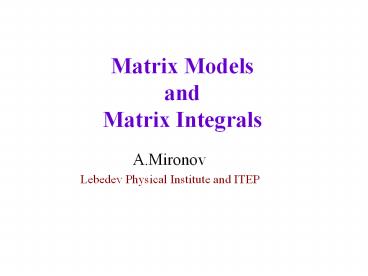Matrix Models and Matrix Integrals - PowerPoint PPT Presentation
Title:
Matrix Models and Matrix Integrals
Description:
... Vafa (DV) construction (G.Bonnet, F.David, B.Eynard, ... The Bonnet - David - Eynard ... The DV - Bonnet - David - Eynard solution gives rise to a basis ... – PowerPoint PPT presentation
Number of Views:72
Avg rating:3.0/5.0
Title: Matrix Models and Matrix Integrals
1
Matrix Modelsand Matrix Integrals
A.Mironov Lebedev
Physical Institute and ITEP
2
New structures associated with matrix integrals
mostly inspired by studies in low-energy
SUSY Gauge theories (F. Cachazo, K.
Intrilligator, C.Vafa R.Dijkgraaf, C.Vafa)
low-energy effective
action in N2 SUSY
gauge
theory Prepotential
massless
BPS-states
Superpotential in
minima
in N1 SUSY gauge theory
3
- Standard dealing with matrix models
- Dijkgraaf Vafa (DV) construction (G.Bonnet,
F.David, B.Eynard, 2000) - Virasoro constraints (loop equations,
Schwinger-Dyson equations, Ward identities) - Matrix models as solutions to the Virasoro
constraints (D-module) - What distinguishes the DV construction. On
Whitham hierarchies and all that
4
Hermitean 1-matrix integral
W(l)
is a polynomial
1/N expansion (saddle point equation)
5
Constraints
6
Solution to the saddle point equation
1
2
A
B
7
DV construction
An additional constraint
Ci const in the saddle point equation
Therefore, Ni (or fn-1) are fixed
Interpretation (F.David,1992)
C1 C2 C3 - equal levels due to tunneling
0 - further minimization in the saddle
point approximation
8
Let Ni be the parameters!
It can be done either by introducing chemical
potential or by removing tunneling
(G.Bonnet, F.David,
B.Eynard)
i.e.
9
Virasoro loop equations
A systematic way to construct these expansions
(including higher order corrections) is Virasoro
(loop) equations
Change of variables
in
leads to the Ward identities
- Virasoro (Borel sub-) algebra
10
We define the matrix model as any solution to
the Virasoro constraints (i.e. as a D-module). DV
construction is a particular case of this general
approach, when there exists multi-matrix
representation for the solution.
PROBLEMS 1) How
many solutions do the Virasoro constraints
have? 2) What is role of the DV - solutions? 3)
When do there exist integral (matrix)
representations?
11
The problem number
zero How is the matrix model integral defined at
all? It is a formal series in positive degrees of
tk and we are going to solve Virasoro constraints
iteratively.
tk have dimensions (grade) tkk (from Ln or
matrix integral)
ck... dimensionful
all ck... 0
12
The Bonnet - David - Eynard matrix representation
for the DV construction is obtained by shifting
or
Then W (or Tk) can appear in the denominators of
the formal series in tk
We then solve the Virasoro constraints with the
additional requirement
13
Example 1
and
The only solution to the Virasoro constraints is
the Gaussian model
the integral is treated as the perturbation
expansion in tk
-
Example 2
and
One of many solutions is the Bonnet - David -
Eynard n-parametric construction
Ni can be taken non-integer in the perturbative
expansion
14
Where . Note that
We again shift the couplings and consider Z as a
power series in tks but not in Tks
i.e. one calculates the moments
15
Example Cubic potential at zero couplings gives
the Airy equation
Solution
Two solutions two basic contours. Contour the
integrand vanishes at its ends to guarantee
Virasoro constraints!
The contour should go to infinity where
16
One possible choice (the standard Airy function)
Another choice
17
Asymptotic expansion of the integral
Saddle point equation has two solutions
Generally W(x) 0 has n solutions n-1
solutions have smooth limit Tn1 ? 0
18
Cubic example
19
Toy matrix model
are arbitrary coefficients
counterpart of Fourier exponentials
counterpart of Fourier coefficients
20
General solution (A.Alexandrov, A.M., A.Morozov)
At any order in 1/N the solution Z of the
Virasoro equations is uniquely defined by an
arbitrary function
of n-1 variables (n2 variables Tk enter through
n-1 fixed combinations)
E.g.
In the curve
21
Claim
where Uw is an (infinite degree) differential
operator in Tk that does not depend of the
choice of arbitrary function
(T)
Therefore
some proper basis
DV construction provides us with a possible
basis
22
DV basis
1) Ni const, i.e.
This fixes fn uniquely.
2) (More important) adding more times Tk does
not change analytic structures (e.g. the
singularities of should be at the same
branching points which, however, begin to
depend on Tk )
Constant monodromies Whitham system
In planar limit
This concrete Virasoro solution describes Whitham
hierarchy (L.Chekhov, A.M.) and log Z is its t
-function. It satisfies Witten-Dijkgraaf-Verlinde-
Verlinde equations (L.Chekhov, A.Marshakov,
A.M., D.Vasiliev)
23
Invariant description of the DV basis
- monodromies of
minima of W(x)
can be diagonalized
DV basis eigenvectors of
(similarly to the condition )
24
Seiberg Witten Whitham system
Operator relation (not proved)
Conditions blowing up to cuts on the
complex plane
Therefore, in the basis of eigenvectors,
can be realized as
Seiberg - Witten - - Whitham system
25
Conclusion
- The Hermitean one-matrix integral is well-defined
by fixing an arbitrary polynomial Wn1(x). - The corresponding Virasoro constraints have many
solutions parameterized by an arbitrary function
of n-1 variables. - The DV - Bonnet - David - Eynard solution gives
rise to a basis in the space of all solutions to
the Virasoro constraints. - This basis is distinguished by its property of
preserving monodromies, which implies the Whitham
hierarchy. The t -function of this hierarchy is
associated with logarithm of the matrix model
partition function.































